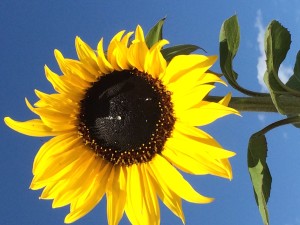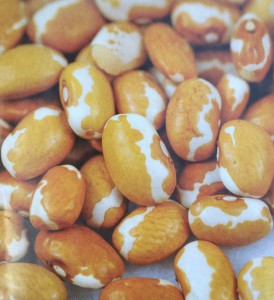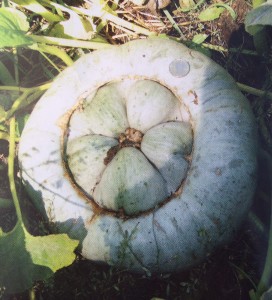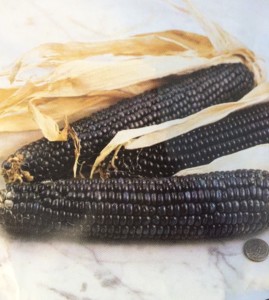NATIVE AMERICAN VEGETABLES
Above we have some illustrations of heirloom Native American vegetables. The sunflower is the rare Hopi Dye sunflower, the beans are Zuni Gold, the squash is from the Ute tribe and the maize is Hopi Blue flour corn ‘Po*suwaegeh’.
It is an interesting fact that some of our most popular vegetables are from the North and South American continents. These include: beans, corn (maize), squash, sunflowers, amaranth, chili peppers, tomatoes, tomatillos, and quinoa. All are plants originally found in the wild, brought into cultivation by Native American peoples. This process, known as domestication, began nearly 8,000 years ago and still continues today. Each growing season, people selected the most flavorful, productive, largest and best-adapted vegetables to eat and to save seed from. Many tribal groups all over the Americas are still growing and saving seed each year. Corn, or maize, as it is properly known, began as a wild grass in central Mexico. The oldest cobs, from archeological sites dating to 6,750 years ago were tiny—only about one inch long! By 1492 six different classes (basic types) of maize had been developed; popcorn, flint, pod corn, flour, dent, and sweet corn, with cob sizes up to 15 inches. The same activity of selecting the best of the best was undertaken for each of the vegetables listed above.
It can be seen from the list that without exception, all these plants are tropical or subtropical in origin. People who lived in the north, or at higher elevations as we do, needed varieties that would mature earlier, in time for harvest and storage. By gradually selecting for early maturity season after season, these crops could be grown in areas with shorter and cooler seasons. The Mandan and Hidatsa in the Dakotas developed early varieties of beans, corn, squash and sunflowers. In the American Southwest the Hopi, San Filipe Pueblo group, Taos Pueblo group and others at high elevations developed early strains as well. Early-maturing types of quinoa, tomatoes, amaranth, maize and chilies were developed in the high mountains of Central America and the Andes Mountains.
In our local area, Western Montana, we are fortunate to be able to grow a number of heirloom vegetables from various tribes living in short season areas. I grow over 30 different varieties of these vegetables here in Ronan. Some are quite rare now and we need to preserve them. An advantage is that growing them here season after season will result in locally-adapted strains. All of these traditional Native American vegetables are open-pollinated, so seed can be saved from year to year. Of course, these are not hybrids, nor are they GMO strains. However, caution must be observed in seed-saving. Maize is wind-pollinated, so each variety must be isolated from other maize varieties to remain pure and prevent pollination by GMO or other strains of maize. You need to grow more than 200 plants of maize each year to avoid inbreeding depression, which results in infertility and non-viable or no seed.
In my garden I have had good luck maturing Hidatsa beans, San Filipe chilies, yellow and white Scallop summer squash, Crookneck winter squash, Navajo and Long Pie pumpkins, and Hopi Dye sunflowers. Next year I am planning a much larger garden and will test more varieties.
Some of the virtues of heirloom Native American vegetables are that they are adapted to the American climate, store well, are open-pollinated, easy to grow organically and resistant to pests and diseases. Another important factor to remember is that vegetables are very healthy for the body and much superior to the packaged, additive-laden food so popular today. A diet rich in vegetables can also reduce the instance of diabetes and other diseases.




